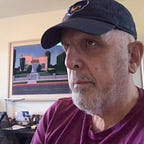Rudy Giuliani: From Busting the Mob to Borat Stooge
Random fact: I interviewed Rudy Giuliani for a newspaper article 35 years ago.
Reluctant admission: I was really impressed.
Current view: Anxiously waiting for Friday to view the new Borat film to see if he really is lying on the bed with his hand down his pants, as is being reported.
The Five Families
In the 1980s, I was running a one-person news bureau in New York City for The Dallas Morning News. Giuliani was the U.S. attorney from New York’s Southern District, and was gaining a national reputation for putting mafiosos in jail. The Morning News was in a newspaper war with the Dallas Times Herald (there were things like that back then!), the Times Herald also had a New York bureau and I wanted to get to Giuliani before the competition.
All I had to do was ask … the Morning News was (and continues to be) a highly regarded paper. And Giuliani already was known for his affection for attention.
He, in fact, was an emerging hero. The next Thomas Dewey (look him up).
In a single day a month earlier, February 1985, law-enforcement officials had rounded up the alleged bosses of all five of New York’s mob families after they were named in a federal indictment on charges of conspiring to control a host of criminal activities, including labor racketeering, gambling, extortion and drug trafficking.
The bust had generated national — and international — notice.
The RICO Assault
I met with him on a late weekday afternoon in his downtown Manhattan office. He was 40, I was 36; he loved baseball and I loved baseball. So, it was natural to begin by talking about the Yankee hat sitting on a shelf. And then he quickly pulled out an autographed baseball. (I don’t remember who had signed it.)
We spoke for two hours. He never seemed to rush me or grow impatient and he was nothing like what we see in today’s Giuliani.
He was being lauded by legal officials and experts for being innovative for mounting a frontal assault on the mob’s inner sanctum, known as the “commission.” He had come up with the theory that it might be possible to convict the five alleged leaders — Paul “Big Paul” Castellano, Anthony “Fat Tony” Salerno, Gennaro “Gerry Lang” Langella, Anthony “Tony Ducks” Corallo and Phillip “Rusty” Rastelli — not of specific crimes but of directing a criminal empire.
The idea had come to him in 1983 as Giuliani — who grew up wanting to be a prosecutor — prepared to leave his post as an assistant attorney general in Washington, D.C., for the New York-based position. “I was reviewing all the pending organized crime investigations,” Giuliani told me, “and that’s when I first developed the theory of a case against the commission structure.”
The theory was this: Under the 1970 Racketeer Influenced and Corrupt Organization Act, known as RICO, prosecutors could pursue the leaders of any “enterprise” that shows a pattern of criminal acts, even when the government can’t prove the leaders committed specific crimes. (The law also empowered the government to seize mobsters’ ill-gotten gains and sets stiffer prison terms than provided under other racketeering charges.)
Giuliani’s first task was to delineate the enterprise and the pattern of the five New York mob families. Working mostly from public material such as newspaper articles, the book The Valachi Papers and a biography of the late mobster Joe Bonanno, Giuliani began to fill in names on an organizational chart.
Then he took his chart to Washington and showed it to FBI Director William Webster and then-Attorney General William French Smith. With information from federal officials, he filled in still more names of mob bosses and underbosses.
“Finally, we looked at the chart, saw the blanks that were left and I said, ‘We have to complete the parts that are open before we can make a case’,” Giuliani said.
Filling in the final blanks required more than sifting through documents.
The investigation eventually involved 175 FBI agents, 25 New York City detectives, nine U.S. attorneys and representatives of the Kings County (Brooklyn) district attorney and the U.S. attorney general — as many as 150 investigators at any one time.
The Aftermath
“They will learn lessons from these cases, so we will have to think about different techniques for investigating,” he told me confidently. “But we sure got a lot of mileage out of this.”
Interestingly, neither Ukraine nor Hunter Biden came up in the conversation. Of course, Ukraine was still part of the Soviet Union back then and Hunter Biden was just 15.
But, as I said earlier, he was not anything like today’s Giuliani.
Anyway, looking forward to watching Borat on Friday.
###
